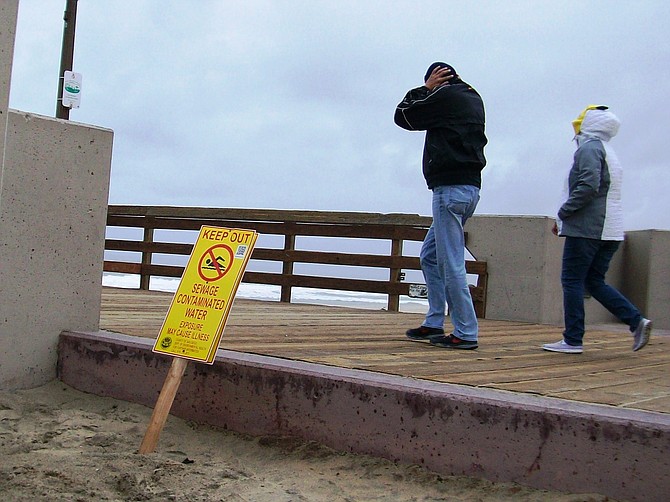 Facebook
Facebook
 X
X
 Instagram
Instagram
 TikTok
TikTok
 Youtube
Youtube

The rain that started on January 4th closed the beaches in south San Diego due to water contamination.
These beach closures continue long after rainstorms because of inaction at the sewage treatment plant in Mexico, according to Imperial Beach city officials and environmental groups. They also say U.S. government officials are failing to adequately respond to the problem, but the officials say they are doing all they can.
Tijuana's CILA treatment plant, designed to handle only dry-weather water flow, shuts down and diverts raw sewage into the Tijuana River basin every time it rains, resulting in beach closures from Imperial Beach to Coronado. (CILA is the acronym for Mexico’s International Boundary and Water Commission).
At issue is the CILA plant's diverter mechanism that is switched on when stormwater flows exceed the maximum 1000 liters per second that the plant is designed for.
According to Paloma Aguirre, the U.S.-Mexico Border director for Wildcoast, the untreated wastewater is allowed to flow after the rainstorms end, even when the water flow falls below the 1000-liters-per-second level, which usually happens two days after the end of the rainfall.
Aguirre said the CILA station did not go back online until seven days after the rainfall on Sunday, October 4.
"The pump station should have been on on Tuesday at the latest," Aguirre said. "Three days after it stopped raining, it was not turned on. So, two days turned into three, which turned into four which turned into a week," she said.
However, U.S. International Boundary & Water Commission spokesman Mario Montes denied that the plant was offline that long. "The pump was turned back on October 8," Montes said. "At the CILA pump, I think they had some problems."
The IBWC is responsible for making agreements with its Mexican counterpart, CILA.
Montes said that restarting the station is not so simple. "It has to be shut down and cleaned," he said. "They can't just turn it back on when the rain event is over. It depends on the amount of trash and debris."
Chris Helmer, environmental programs manager for Imperial Beach, said this unclogging of the diverter takes too long. “The IBWC goes through the exact same procedure, but the U.S. agency is fast to respond. The Mexican agencies are not."
Montes said, “You're working with another country...the USA can't just go in and do whatever it wants. We have to work with them and see what's best for both countries. You can't have results in a week…. Work groups have to be formed, assessments made, funding found."


The rain that started on January 4th closed the beaches in south San Diego due to water contamination.
These beach closures continue long after rainstorms because of inaction at the sewage treatment plant in Mexico, according to Imperial Beach city officials and environmental groups. They also say U.S. government officials are failing to adequately respond to the problem, but the officials say they are doing all they can.
Tijuana's CILA treatment plant, designed to handle only dry-weather water flow, shuts down and diverts raw sewage into the Tijuana River basin every time it rains, resulting in beach closures from Imperial Beach to Coronado. (CILA is the acronym for Mexico’s International Boundary and Water Commission).
At issue is the CILA plant's diverter mechanism that is switched on when stormwater flows exceed the maximum 1000 liters per second that the plant is designed for.
According to Paloma Aguirre, the U.S.-Mexico Border director for Wildcoast, the untreated wastewater is allowed to flow after the rainstorms end, even when the water flow falls below the 1000-liters-per-second level, which usually happens two days after the end of the rainfall.
Aguirre said the CILA station did not go back online until seven days after the rainfall on Sunday, October 4.
"The pump station should have been on on Tuesday at the latest," Aguirre said. "Three days after it stopped raining, it was not turned on. So, two days turned into three, which turned into four which turned into a week," she said.
However, U.S. International Boundary & Water Commission spokesman Mario Montes denied that the plant was offline that long. "The pump was turned back on October 8," Montes said. "At the CILA pump, I think they had some problems."
The IBWC is responsible for making agreements with its Mexican counterpart, CILA.
Montes said that restarting the station is not so simple. "It has to be shut down and cleaned," he said. "They can't just turn it back on when the rain event is over. It depends on the amount of trash and debris."
Chris Helmer, environmental programs manager for Imperial Beach, said this unclogging of the diverter takes too long. “The IBWC goes through the exact same procedure, but the U.S. agency is fast to respond. The Mexican agencies are not."
Montes said, “You're working with another country...the USA can't just go in and do whatever it wants. We have to work with them and see what's best for both countries. You can't have results in a week…. Work groups have to be formed, assessments made, funding found."
Comments